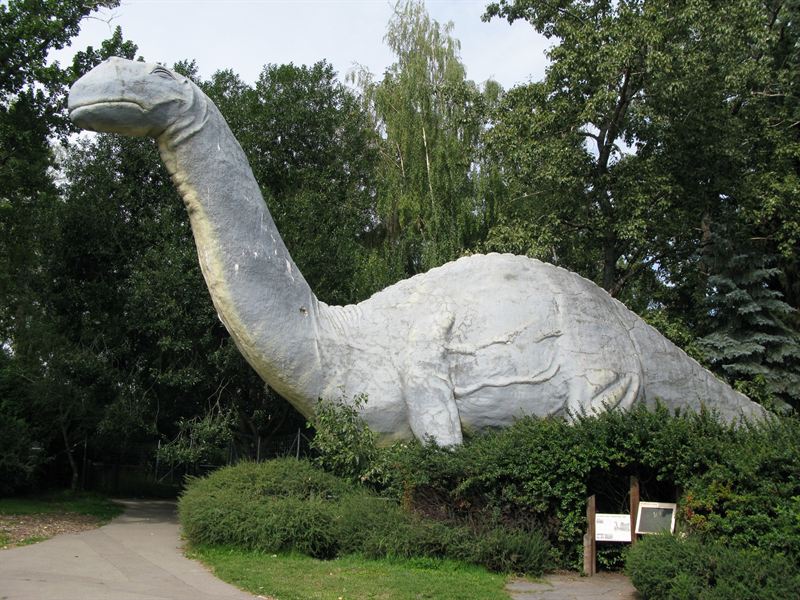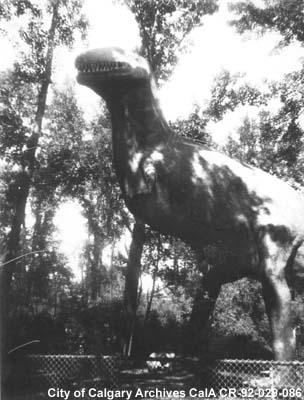Dinny the Dinosaur, constructed 1935
1300 Zoo Rd. N.E., Bridgeland/Riverside
Certainly, if you’ve been to the Calgary Zoo you’ve seen our city’s long-time companion and mascot, Dinny the Dinosaur, but Dinny’s past isn’t the sort you dig up in the badlands. Dinny is a concrete brontosaurus sculpture that was built at the west end of St. George’s Island in 1937. The model is twelve metres tall and thirty-six metres long, and weighs 110 tonnes. It is the only remnant of the Calgary Zoo’s original Natural History Park that was conceived and developed during the Great Depression.
John Kanerva (1883-1974), a Finnish-born artist, designed and built most of the park’s fifty-six sculptures. With the park’s official opening in 1937, the zoo was renamed the Calgary Zoo and Natural History Park. The Zoo dismantled the prehistoric park in 1983, and apart from Dinny, all of the sculptures were destroyed. An updated Prehistoric Park with new sculptures of dinosaurs and other prehistoric creatures opened at the north end of the zoo in 1984. Pictured below are Kanerva and some park-goers at the original Natural History Park (R), and one of the original dinosaurs featured in the park.
Dinny the Dinosaur is the sole remaining in-situ sculpture of the original Dinosaur Gardens; the first of its type in North America. It is constructed of hand-formed concrete placed on a steel and wire mesh armature with a hollow interior cavity. It was/is highly visible and became the symbol of Calgary being superceded by the Husky Tower in 1968.
Calgarians were interested in natural history long before the zoo opened its Natural History Park in 1937. Beginning around 1912, American paleontologists like Barnum Brown and Charles H. Sternberg and his sons began excavating dinosaur fossils in the nearby Badlands along the Red Deer River. In 1912, a group of citizens formed the Calgary Natural History Society, and from 1914-27 this group maintained a natural history museum in the basement of the Court House. The Society then sold its collection to the City of Calgary, and from 1928-35 the City operated the Calgary Public Museum on the main floor of the North-West Travellers Building. The museum’s natural history component included a fossilized dinosaur skeleton. In 1928, Dr. Charles M. Sternberg of the Geological Survey of Canada (and son of Charles H. Sternberg) presented a public lecture and film on “Hunting Dinosaurs in the Bad Lands of Alberta” at the Grand Theatre. At an unknown date in the mid to late-1920s, a Calgary cinema showed The Lost World (1925), a film adaptation of Sir Arthur Conan Doyle’s 1912 adventure novel about dinosaurs that survived into the twentieth century. John Kanerva saw the film and cited it as the source for his lifelong interest in dinosaurs.











